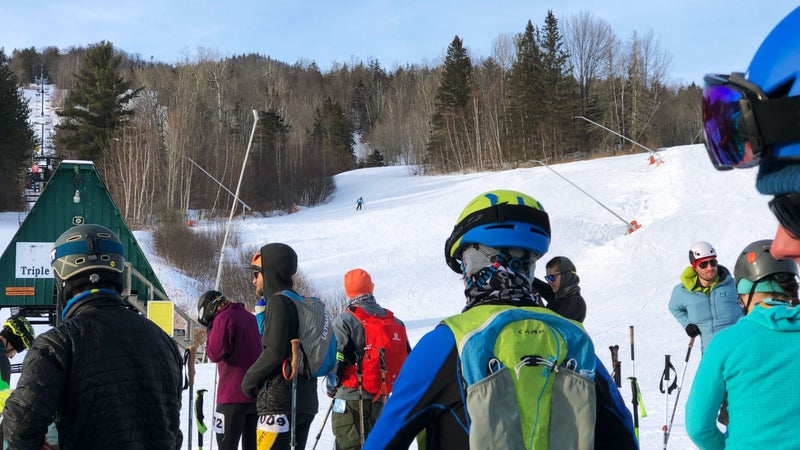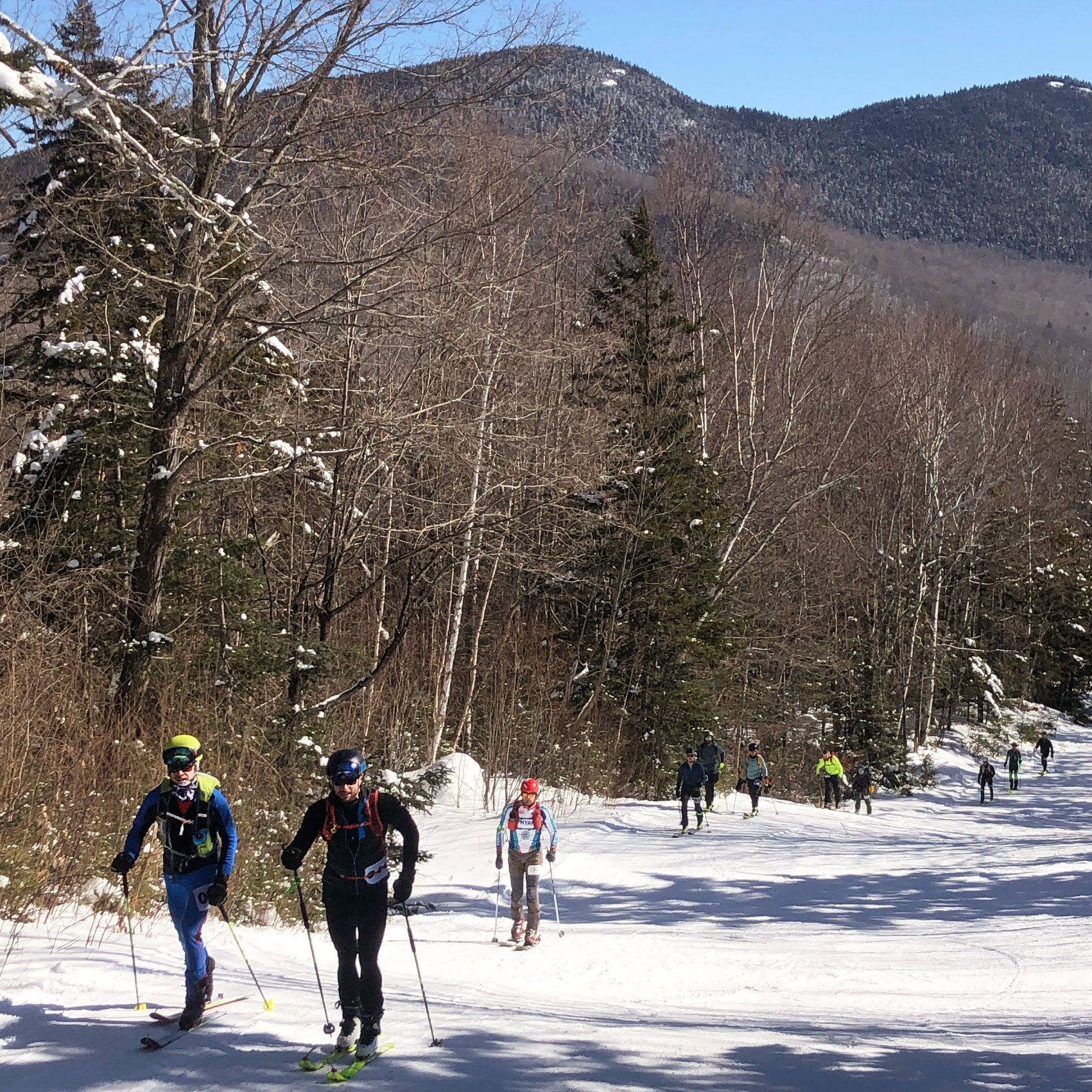From the parking lot, it looked like a normal morning at Black Mountain. The small New Hampshire ski area was blanketed in sunlight, and guests meandered toward the green, chalet-style lodge, as if the thermometer didn’t read zero degrees Fahrenheit.
But just out of sight, on the far side of the lodge, a group of 61 people stood with their tips pointed uphill. And a tall man in a red North Face expedition suit was pointing a megaphone straight at them.��
“The whole idea of this event is to push yourself,” Andrew Drummond boomed, as his Australian shepherd wiggled through the crowd. “I think a lot of you will be surprising yourselves today, because this format is meant to really tap into that next level of what’s possible through pacing. Be responsible, have fun, and thank you for coming to this crazy event.”
This crazy event is called Last Skier Standing, and this is how it works: participants have 60 minutes to ascend and descend Black Mountain, which is roughly a thousand vertical feet. When those 60 minutes are over, they line up at the start and do it all over again, then again, and again, until they can’t do it anymore. One lap per hour, and the last skier standing wins. Everyone else takes a DNF.
While innovative, the concept behind Last Skier Standing was not born at Black Mountain. It was born through ultrarunning, specifically at a race known as Big’s Backyard in Bell Buckle, Tennessee. At that race, runners complete a 4.166667-mile trail once per hour, meaning anyone who makes it 24 hours runs 100 miles. The current record is 68 laps, or 283.335 miles. And ever since that race began, in 2012, its format has been replicated around the world many times over but never on snow—until Last Skier Standing was held on February 15.��
The organizer with the megaphone, Drummond, is a legend on the East Coast, well known for crushing ultramarathons and ski touring on Mount Washington. But perhaps even better known is his brand, , which sells outdoor equipment and hosts weekly ski-mountaineering and running races. Last July, Drummond held a Big’s Backyard look-alike contest on his parents’ 350-acre property. The race was fairly informal and drew a small crowd, but the feedback was consistently positive: every lap was a blast.
“One of the guys came to me and asked if I’d thought about doing this for skiing,” said Drummond. “I said no—it seemed totally absurd to me. I didn’t think anyone would ever want to do that. But I didn’t dismiss it completely and brought it up with a couple of other friends. They said we should absolutely do it, so we got to work and started planning this thing.”

At the count of ten, the herd of 61 began moving up Black Mountain. Entrants ranged in age from 18 to 65. Some squeezed into tight skimo race suits. Others wore insulated jackets and heavy backpacks. Their backgrounds and strategies differed greatly, but everyone seemed to share the same loose-screw mentality. After the first three laps—the first three hours and 3,000 vertical feet—all 61 racers on Black Mountain remained standing.��
Among the group was Adam Jaber, a 25-year-old skier from West Springfield, Massachusetts, known best within the outdoor industry for his Q-and-A-style podcast, .��
“I’m just going to keep it at a conversational pace, literally,” he said. “If I can’t keep talking people’s ears off on the way up, I’ll know I’m in trouble.”
By the tenth lap—ten hours and 10,000 vertical feet into the event—43 competitors remained. But it was 8 P.M. and cold. Moods seemed a little less happy and a lot more skeptical. And by the 14th lap, the field had been whittled down to 21.
One of them was Rick Chalmers, a 58-year-old carpenter from South Portland, Maine. Chalmers had gray hair escaping from his helmet and heavy gear strapped to his feet. On the first handful of laps, he finished dead last and it seemed that, perhaps, the second-oldest man on the hill would be calling it quits. But it was all part of his strategy.��
“I’m here to finish. I’ve got notes and everything,” he said matter-of-factly, as he ascended into the night. His notes read:
- Lap 1: 10 a.m. Patience and focus.
- Lap 3: 1 p.m. Remain calm.
- Lap 4: 2 p.m. Eat 3 oysters.
- Lap 6: 4 p.m. Headlamp and CSD skins for night laps.
- Lap 9: 7 p.m. Stromboli.
- Lap 13: 11 p.m. Eat 3 oysters.
- Lap 16: 2 a.m. These next 3 laps will be very difficult.
As the night came and went, the field continued to thin. And by the time the sun rose—21 hours and 21,000 vertical feet on—just eight men remained. Day skiers began arriving at the lodge again.��
Often leading the pack from the beginning of the race was a 31-year-old chiropractor from Portsmouth, New Hampshire.��Kanoa King is an avid ultrarunner with results under his belt to show for it. A month before Last Skier Standing, he set a PR at the Houston Marathon with a time of 2:40:08.��
“You’re at 24 laps, and it dawns on you that if you do five more, you’re hitting the elevation of Everest at 29,” he said. “I’m thinking to myself, that’s only five more hours. I already did 24 of these, I could do five more.”
So King did do five more. And so did Chalmers, while the rest of the racers faded away. All of the sudden, the event was no longer about how long these skiers would go but instead when the hell they’d stop.��
On the 33rd lap, King bowed out. And that meant Chalmers had one last thing to do: one more lap, all by himself, to truly become the Last Skier Standing.
“You’re at 24 laps, and it dawns on you that if you do five more, you’re hitting the elevation of Everest at 29.”
“I had my final oysters on the 30th hour. I didn’t have any more oysters had it gone to 35 hours,” said Chalmers, speaking to his oysters-every-five-hours strategy. (Unshucked oysters because they’re delicious and salty. And every five hours so he always had something to look forward to.) “I was very cold, very wet. I was a mess. I could barely function. All I could do was take skins off, put skins on, ski up, ski down, and eat a little.”
All alone, Chalmers crossed the finish line at 7:40 P.M., after 34 hours, 34,000 vertical feet, and not a single wink of sleep. At the base, he was welcomed with open arms by his competitors, the volunteers, and the spectators. And while Last Skier Standing certainly has a nice ring to it, the nickname Oyster Rick seemed a lot more fitting.��
“Everyone keeps calling this a sufferfest,” he said. “It wasn’t a sufferfest. Maybe it was. But I loved every step. Some of them were hard, sure, but it’s a joy to be skiing with a headlamp in the middle of the night, looking at the stars. Especially when you’re delirious.”
Back around the seventh lap of the race, Cody Townsend stopped by to witness the delirium of Last Skier Standing in person. The California-based pro skier had just completed a line on nearby Mount Washington for his yearslong film project, .��
“I’ve always wondered why there’s so much pride with East Coast skiers. I thought it was just shitty skiing, terrible weather, and flat mountains,” he said. “I kind of came here to answer that question for myself. And what I’m learning is that skiing here is about so much more than just skiing.” He gestured toward the racers as they vanished up and over the first pitch, into the darkness.“You come here to Black Mountain and it’s like, oh, this is where the soul of skiing is. It’s right here.”


